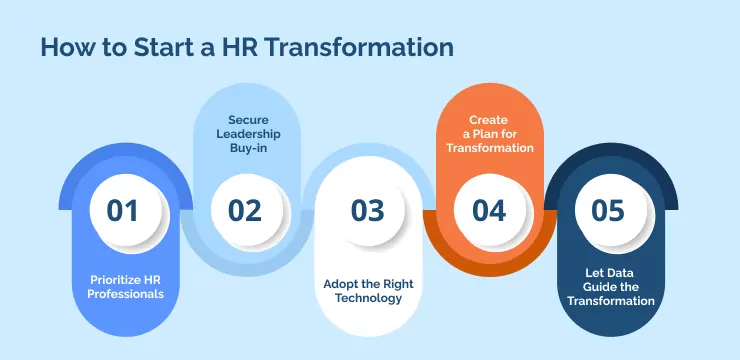HR Digital Transformation Roadmap: 3 Best Examples

HR digital transformation entails the transition of operational HR processes towards automation and data-driven approaches. To ensure its success, this transformation should encompass the entire organization.
The need for HR digital transformation arises from business leaders’ emphasis on enhancing employee performance through strategic development initiatives. These leaders aim to standardize internal HR processes using industry best practices. A successful HR transformation strategy is centered around multiple objectives that seek to elevate the employee experience.
Transformation of HR
Transforming HR through technology has become a significant focus for many organizations. Technology can streamline HR processes, improve efficiency, enhance employee experience, and enable data-driven decision-making.
Human resources digital transformation involves adopting digital solutions to automate and streamline administrative tasks, enhance employee experience, enable data-driven decision-making, and drive overall HR effectiveness and efficiency.
Developing an HR transformation plan can be a comprehensive and strategic process, including processes, systems, capabilities, and challenges. Understanding the organization’s overall business strategy and goals.
When developing an HR digital transformation strategy, consider the specific objectives and outcomes you aim to achieve through digital transformation. This could include improving HR processes, enhancing employee experience, enabling data-driven decision-making, or increasing HR efficiency.
Digital Strategy is one of the implementations of a cloud-based HRIS (Human Resources Information System). This strategy involves transitioning from traditional, paper-based HR processes to a centralized digital system hosted in the cloud.
HR and digital transformation

HR and digital transformation go hand in hand, as HR plays a crucial role in driving the adoption of digital tools, upskilling the workforce, and aligning HR strategies with digital initiatives.
Digital transformation in human resource management refers to leveraging technology and digital solutions to automate processes. Examples of digital solutions that can be used in HR management include:
- Human Resources Information System (HRIS)
- Applicant Tracking System (ATS)
- Learning Management System (LMS)
Digital transformation in HR enables HR professionals to generate reports and dashboards with key HR metrics, aiding in data-driven decision-making.
HR digital transformation examples
Here are a few examples of powerful digital possibilities for your organization.
1. Digital onboarding
Digital onboarding serves as a noteworthy illustration of how HR transformation is revolutionizing conventional HR practices. It signifies a transition from manual, paper-based onboarding processes to more streamlined and technology-driven approaches.
2. ESS portals
Employee self-service portals (ESS) exemplify a notable instance of HR digital transformation as they bring about fundamental changes in how employees access HR services and information. These portals not only empower employees with greater control and convenience but also enable HR teams to operate more efficiently.
3. AI-powered applicant tracking systems
AI-powered applicant tracking systems (ATS) bring about a revolutionary transformation in traditional recruitment and talent acquisition processes by incorporating artificial intelligence and automation. These systems leverage AI to identify keywords, qualifications, and relevant experience, allowing recruiters to streamline the candidate shortlisting process. By analyzing real-time data on candidates’ skills, qualifications, and experiences, AI helps identify the most suitable candidates for specific roles.
4. HR chatbots
HR chatbots provide employee support around the clock, departing from the traditional limitations of HR service hours. This accessibility allows employees to obtain assistance and information at any time, thereby improving convenience and flexibility. The transition to continuous support aligns with the contemporary work environment, which often extends beyond regular business hours. With the capability to offer personalized responses based on employee data and preferences, advanced chatbots can provide tailored recommendations on benefits, learning, and development opportunities, bolstering the employee experience and engagement.
5. Cloud-based HCM and HR systems
Cloud-based human capital management (HCM) systems represent a notable shift in HR management and administration, demonstrating the transformative power of technology in organizations. Traditional HR processes, relying on manual paperwork, spreadsheets, and on-premises software, often resulted in inefficiencies, data fragmentation, and restricted accessibility. In contrast, cloud-based HR systems utilize cloud technology to consolidate and simplify HR functions, enabling centralized management and improved efficiency.
Why do you need an HR Digital Transformation?
HR transformation initiatives concentrate on reorganizing the company and aligning policies with future needs. These activities encompass talent management tracking, adopting cutting-edge technology, and embracing performance data analytics.
Transformational activities aim to revamp hierarchical structures and establish stronger connections with employees. This, in turn, enhances the employee experience and subsequently improves performance. In today’s fast-paced business landscape, becoming a technology-driven organization is particularly crucial to staying abreast of ever-evolving trends.
The importance of HR Digital Transformation
In today’s rapidly changing business landscape, every organization is confronted with a crucial decision. Leaders must choose between retaining outdated frameworks that are becoming obsolete or embracing innovative tools and operational models as they envision new approaches to work.
The role of HR in digital transformation
The role of HR in digital transformation is to align HR strategies with digital initiatives, identify digital skills gaps, facilitate digital upskilling, foster a digital culture, drive change management, and ensure the workforce is prepared for the digital changes happening within the organization.
The 2017 Human Capital Trends report by Deloitte emphasizes the need for HR teams to undertake a twofold task: revolutionizing HR operations and revolutionizing the workforce and work processes. This implies that HR digital transformation extends beyond the HR department and requires the involvement of the entire organization for it to be successful.
1. Recruitment and Talent Acquisition:
Artificial intelligence (AI) and machine learning algorithms offer the capability to swiftly evaluate resumes, eliminating the need for manual screening. They can also assess candidates more fully, enabling HR to gain a better understanding of their skills and abilities. This advanced technology aids in the identification of the most suitable individuals for the job position.
HR professionals should prioritize establishing a workplace environment that acknowledges and appreciates the contributions of all individuals while also fostering opportunities for personal and professional development. This can be achieved by encouraging employee participation in decision-making, employing data-driven methods for problem-solving, and creating flexible and fulfilling work environments.
HR should work in collaboration with various departments to identify areas where skill gaps exist and develop strategic learning initiatives that align with the organization’s goals. This approach ensures that employees are equipped with the necessary knowledge and skills to stay relevant and competitive in today’s job market. Moreover, it cultivates a culture of continuous learning, leading to a more engaged and productive workforce.
With the help of HR analytics tools and software, HR departments can analyze data about employee performance, engagement, and turnover rates. This enables HR to optimize its recruitment, hiring, and retention processes by identifying and attracting top talent. Additionally, it empowers HR to develop and implement strategies that drive business success and confer a competitive advantage.
How to Start a HR Digital Transformation

There is an increasing demand for HR teams to make a strategic impact and drive business outcomes. As a result, many companies embark on HR transformations to consistently enhance employee performance and optimize organizational operations.
It is crucial to consider the perspective of employees and anticipate how change might affect them. If employees feel excluded from the change initiative or don’t comprehend the rationale behind significant change management, they are likely to resist it. Employee resistance is a prevalent cause of failure in the transformation process.
2. Secure Leadership Buy-in
To achieve successful transformation, it is crucial to involve senior management in the process. It is widely recognized that change starts from the top, as executives play a key role in shaping the company culture. It is important to share the business strategy with senior management early on, gain their buy-in, and secure their full support throughout the transformation. Clearly explaining how HR transformation aligns with critical business goals helps executives understand the value and importance of the initiative.
3. Adopt the Right Technology
Digital transformation and HR change initiatives are frequently intertwined as they share common strategic priorities. Numerous emerging HR technologies, such as artificial intelligence, machine learning, natural language processing, and virtual assistants, hold the potential to revolutionize work processes. By embracing a more digital HR approach, organizations can enhance the effectiveness of HR functions, ultimately influencing performance throughout the entire business.
4. Create an HR transformation plan
HR digital transformation refers to the progressive development of the HR function. It involves the smooth incorporation and alignment of service delivery, talent management, and technology within HR strategy, aiming to generate increased business value. This is achieved by enhancing operational efficiency and making a strategic impact.
A common mistake made by many HR leaders is opting for quick fixes instead of thorough planning when undertaking a change initiative. Planning is a critical yet often overlooked stage in HR transformation. A successful transformation strategy should encompass both overarching business goals and department-specific objectives. It should also identify key individuals and their roles, ranging from the C-suite to smaller HR teams.
Developing an HR transformation plan can be a comprehensive and strategic process, including processes, systems, capabilities, and challenges. Understanding the organization’s overall business strategy and goals.
5. Let Data Guide the Transformation
HR data provides valuable insights into areas that require improvement and facilitates the measurement of progress during the transformation process. Sharing these data insights with leaders across the organization promotes cohesion and alignment among all departments. Embracing data analytics within the HR department is crucial for a digitally-focused enterprise to capitalize on the numerous benefits it offers.
Benefits of HR Digital Transformation
Organizations must quickly adapt their strategies to thrive in the modern work environment. As a result, HR transformation has become essential for businesses that aim to outperform their competitors.
HR leaders have assumed a crucial role in shaping the future of the organization by establishing a new framework for effective talent management. Stakeholders throughout the organization need to acknowledge the significance of HR and collaborate closely with HR leaders to accomplish strategic objectives.
This transformation process brings numerous transformative advantages that can significantly impact the game:
- Boost efficiency and productivity
- Provide access to more data
- Simplify recruitment and hiring processes
- Facilitate learning and development
- Enable DEI
- Improve performance management
While technology offers numerous advantages, it is crucial to understand that it is not a panacea for all challenges. Technology is designed to simplify tasks, but it cannot solve every problem. As an HR leader, it is important to approach technology investments with a discerning mindset. Carefully evaluate the value and relevance of each investment and consider timing to ensure that it aligns with your organization’s needs and goals. Taking a critical and strategic approach to technology adoption can lead to effective and impactful outcomes.
HR Digital Transformation Roadmap

There are several compelling reasons to embrace HR digital transformation. When you are prepared for change and navigate through the associated challenges, it becomes crucial to develop a roadmap and assess your priorities. The roadmap plays a critical role in mitigating the risk of project failure and optimizing implementation costs.
1. Focus on a people-first approach
A primary and progressively significant approach is to prioritize human capital as the focal point of your HR digital transformation initiative.
2. Assess change management
In the face of geopolitical conditions and other uncertainties, organizations are consistently confronted with rapid disruptions in various work processes. These disruptions can lead to specific vulnerabilities, such as employees experiencing change fatigue and compromised work experiences.
3. Assess existing HR technology
It is crucial to reevaluate the suitability of your current tools for adapting to new technology and work processes. For instance, you can assess your enterprise systems, such as HRMS or HCM tools, to determine their compatibility with automation solutions.
4. Identify the areas of transformation in HR
Assess the HR processes that require immediate transformation in terms of enhancing employee experience and productivity. Determine whether an automation solution is necessary for all these processes or if it is sufficient to implement automation in specific areas of work.
5. Ensure smooth integration of new technologies
Engaging in a collaborative discussion regarding new initiatives is highly beneficial for minimizing integration risks and ensuring the successful deployment of solutions promptly. This approach enables organizations to start capitalizing on the advantages of automation and maximize their investment in the new technology.
6. Develop a culture of collaboration
It is essential to gather employee feedback to evaluate the performance of the project and identify areas for improvement. Through the process of reassessment, organizations can enhance efficiency and foster employee confidence.
7. Implementation deadline
For larger organizations, it is advisable to implement the solution in phases. On the other hand, small or midsized businesses can explore alternative approaches when devising their implementation plan. Conducting a small-scale proof-of-concept experiment can be beneficial. Rather than implementing a complete transformation across all HR operations, it is recommended to begin with one specific area of the process.
8. Select your vendor wisely
Off-the-shelf HR automation tools offer quick implementation, but they may have limited customization options and scalability. If your goal is to align automation with specific business objectives, it is advisable to select solutions that can deliver long-term cost savings and operational efficiency. One emerging technology that plays a significant role in HR transformation is conversational AI chatbots. A conversational AI platform serves as a valuable tool for creating personalized dialogues or FAQ-based questionnaires to address various employee issues on a larger scale.
HR digital strategy
When selecting a new solution, it is important to assess its compatibility with existing workflows and processes. If the integration is too complex, it may impede the implementation and long-term adoption of the system.
To ensure successful adoption, it is crucial to effectively communicate the benefits of the solution to employees. If they do not understand the necessity or the impact it will have on their work, they may be resistant to change. Allocating ample resources for comprehensive training, both for administrators and users, is essential. Gaining buy-in and providing thorough training significantly contribute to widespread adoption within the company.
Winning with HR Transformation
HR digital transformation can involve both small and large-scale changes, but it primarily focuses on making comprehensive and fundamental changes to company practices. Even when the transformation is centered around a single issue, it is a challenging endeavor that requires considerable time and effort. As showcased in a Gartner case study, achieving a mindset change like “digital dexterity” for an organization like Sammons Financial necessitated a significant investment of resources.
Thankfully, there is no secret recipe for achieving a successful HR transformation. By fostering better leadership, adopting suitable operating models, enhancing HR capabilities, and leveraging technology, your HR department can steadily improve and thrive.
Challenges of HR Digital Transformation
Although the outcome of digital transformation is appealing, it requires significant effort to achieve. It is important to take into account the following considerations:
- Encouraging adoption of new solutions: Assess employee skill gaps and provide comprehensive training to ensure smooth adoption of new technologies.
- Establishing a culture of continuous learning: Foster an environment that promotes ongoing learning and keeps employees updated on technological advancements.
- Monitoring performance: Implement a strategy to regularly evaluate the impact and effectiveness of new solutions, and compare them to competitors to ensure optimal results.
See More:
- Best Financial Digital Transformation Services: Trend | Future
- What is the Digital Transformation in Local Government: Benefits| Challenges
- Digital Transformation in Business: Trend| Future| Benefits
- Digital Transformation in Government and Public Sector: Challenges| Benefits| Trends
- 10 Top Digital Transformation Tools List
- Human-Centered Digital Transformation: Tech Secrets Gen5
- Digital Transformation Speakers
- How to Build an Agile Transformation Roadmap: 3 Effective Way




